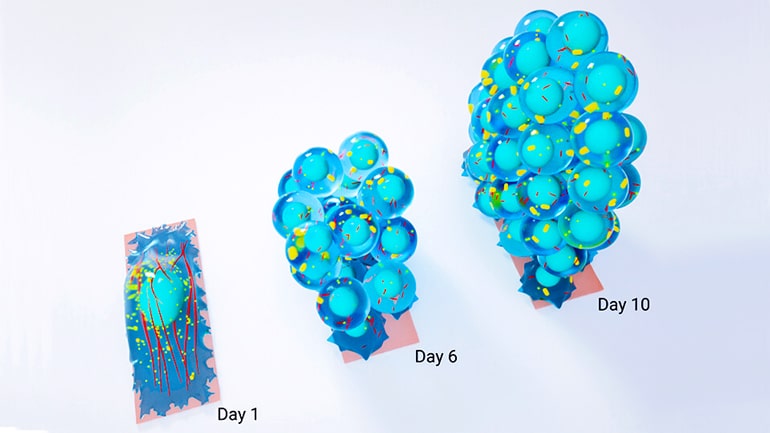Researchers have found how to reprogram mature cells into redeployable stem cells without direct genetic modification by confining them to a defined space for an extended period of time.
“Our breakthrough findings will usher in a new generation of stem cell technologies for tissue engineering and regenerative medicine that may overcome the negative effects of genomic manipulation,” says G.V. Shivashankar of the Mechanobiology Institute at the National University of Singapore and the FIRC Institute of Molecular Oncology in Italy.

Turning back time
It’s been over a decade since scientists first showed they could reprogram mature cells in the lab to become pluripotent stem cells that are capable of developing into any cell type in the body.
In those early studies, researchers genetically modified mature cells by introducing external factors that reset the genomic programs of the cells, essentially turning back the clock and returning them to an undifferentiated or unspecialized state. Scientists can then reprogram the resultant lab-made cells, known as induced pluripotent stem cells (iPSCs), into different cell types for use in tissue repair, drug discovery, and even to grow new organs for transplant. Importantly, scientists did not need to harvest these cells from embryos.
“The use of geometric constraints to reprogram mature cells may better reflect the process occurring naturally within the body…”
However, a major obstacle is the tendency for any specialized cell that develops from iPSCs to form tumors after introduction into the body. To understand why this occurs, researchers turned their focus to understanding how the body regulates stem cell differentiation and growth, and in particular, how cells naturally revert to an immature stem cell-like state, or convert to another cell type, during development, or in tissue maintenance.
The researchers have shown that they can reprogram mature cells, in vitro, into pluripotent stem cells without genetically modifying the mature cells, simply by confining the cells to a defined area for growth.
Reset and redeploy
When researchers confined fibroblast cells (a type of mature cell found in connective tissue such as tendons and ligaments) to rectangular areas, they quickly assumed the shape of the substrate (the surface or medium that the cells are attached to). Based on previous work from the Shivashankar lab, this indicated that the cells were measuring and responding to the physical properties of their environment, and conveying this information to the nucleus where DNA packaging and genome programs would adapt accordingly.
The team grew the cells over 10 days until they formed spherical clusters of cells. Genetic analysis of the cells within these clusters revealed they lost specific characteristics of chromatin (the condensed form of packaged DNA) normally associated with mature fibroblasts by the sixth day. By the 10th day, the cells expressed genes normally associated with embryonic stem cells and iPSCs. The researchers have now learned that by confining the mature cells for an extended period of time, they can turn mature fibroblasts into pluripotent stem cells.
To confirm that the fibroblasts had indeed become stem cells, the researchers then directed their growth, with high efficiency, into two different specialized cell types. Some cells turned back into fibroblasts.
Step forward for stem cells
The physical parameters used in the study are reflective of the transient geometric constraints that cells face to in the body. For example, during development, the establishment of geometric patterns and niches are essential in the formation of functional tissues and organs.
Similarly, after tissue damage, either through injury or disease, cells will experience sudden alterations to their environment. In each case, mature cells may revert back to a pluripotent, stem cell-like state, before being redeployed as specialized cells for the repair or maintenance of the tissue.
“While it is well established that confining stem cells to defined geometric patterns and substrate properties can direct their differentiation into specialized cells, this study shows for the first time that mechanical cues can reset the genomic programs of mature cells and return them to a pluripotent state,” Shivashankar explains.
“The use of geometric constraints to reprogram mature cells may better reflect the process occurring naturally within the body,” he adds. “More importantly, our findings allow researchers to generate stem cells from mature cells with high efficiency and without genetically modifying them.”
The research appears in the Proceedings of the National Academy of Sciences.
Source: National University of Singapore



